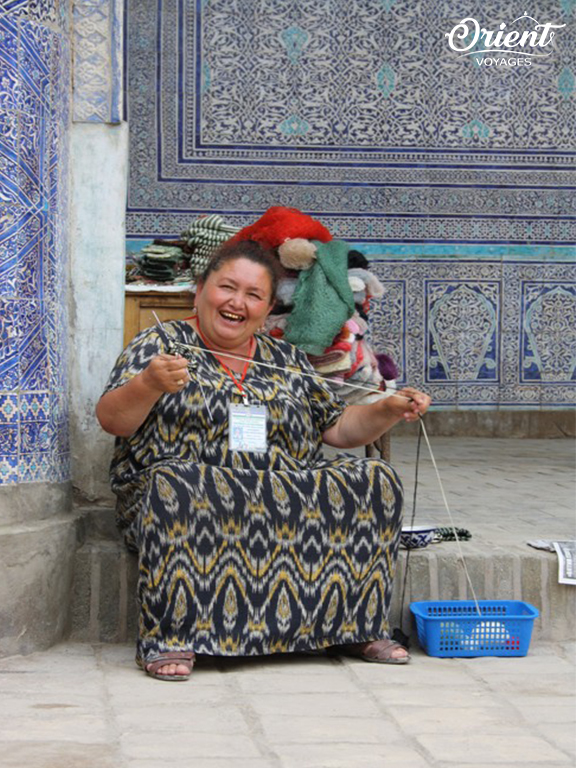-
Khiva, main gates Ota Darvaza
-
Khiva
-
Bukhara, Nodir Divan-Begi madrassah
-
Bukhara, Ark Fortress
-
Tashkent, Khast Imam Square
-
Bukhara
-
Samarkand, ensemble Shakhi Zinda
-
Bukhara, view on to Miri-Arab madrassah, XVI c.
-
Kyzylkum desert, riding on camels
-
Konigil village, silk paper center, noria
-
Sherdor madrassah, Samarkand
-
Samarkand, Registan Square
Main /
The Great Silk Road
GREAT SILK ROAD
The Great Silk Road, linking the western and eastern parts of the world's largest continent for more than fifteen hundred years, has become one of the greatest achievements of mankind. In it as in a gigantic retort teeming with life was rapidly developing not only trade, but also a variety of industries producing goods that were most in demand. Along with this, there was a big synthesis and enrichment of cultures, the development of the sciences, arts, and crafts.
The Silk Road was a huge system of roads, it would be more correct to say two gigantic road systems, divided by up to the II century BC by watershed ridges of the Tien Shan, Kun Lun, Karakoram, Hindu Kush, Himalaya. Up to this time the inhabitants of Europe, Egypt, Arabia, Mesopotamia (modern Iraq and Iran), the Near East and Central Asia, the Greco-Roman world, which were interconnected by caravan routes for thousands of years, were not even aware of the existence of the huge Chinese Empire, one of the oldest in the world.
In China, closed to the Western world, but possessing an extensive network of roads, too, people were unaware of the existence of literally next door rich land with many prosperous cities. First the Chinese ambassador Zhang Qian managed to see them. He began his trip in 138 BC and after years of ordeal, the ambassador found himself in Central Asia.
He drew up a detailed report to the Chinese emperor about his time in Davan (Ferghana Valley), Kanguy, Sogdiana, Bactria. The latter was tempted with famous Davan fast horses, which in China came to be called "heavenly", they were very much different from the squat local horses. Chinese emperor, according to legend, could ascend to heaven on such horses and become immortal.
In return, the Chinese have offered their goods. According to historians, the first caravan of silk (very compact and expensive goods), as well as the bronze mirrors (and what more!) went from China to Ferghana Valley in 121 BC. The caravan was moving through the Turphan Basin along the Fire Mountains and Tian Shan. In this regard, very interesting is the finding of the Uzbek-French expedition in 35 km from Samarkand. They discovered burial of so-called "Sogdian princess", which was two thousand years old. Among the multitude of gold jewelry scientists found in the burial the Chinese mirror made from a mysterious alloy. Most likely, the "Princess" was wrapped in silk, but the fabric is too ephemeral to survive underground for twenty centuries.
Hitherto unknown Chinese goods, especially silk, were rapidly gaining popularity outside Central Asia, first in Persia, and then all over the western part of the Silk Road, which, incidentally, was called so only in 1877 with the light hand of German geographer and explorer of China, Ferdinand Richthofen.
The Romans called silk the Chinese veil, they paid for it fabulous money, in particular for the fact that silk was practically the only protection against insect pests. The Chinese long kept the secret of their silk, even the Europeans believed that the silk grew on trees. But, as would now put it, as a result of industrial espionage secret was no longer a secret.
Silk was not the only thing that got the Western world as a result of contacts with China. In great demand in the West had been the Chinese finest porcelain with delicate drawings, bronze and lacquer ware, medicines, perfumes, tea, rice, and, of course, paper which manufacturing technology the Chinese have mastered the first, as well as the production of gunpowder. Compass, by the way, was also invented by the Chinese.
China itself also did not remain in the loser. Along with the horses China got food for them - alfalfa. Besides the "heavenly horses" China imported camels, fat-tailed sheep, hounds and even lions and cheetahs.
It began to cultivate cotton caught in caravans, as well as beans, onions, cucumbers, carrots, walnuts, pomegranates, figs, peaches, watermelons, melons and grapes. The Chinese appreciated grape wine as well...
In addition Central Asia supplied China with wool, which was totally unknown there - fabrics, carpets, rugs; as well as ammunition, gold, silver, semi-precious stones, articles of Samarkand glass, leather, cotton and gold embroidered cloth... Through Central Asia in China were brought products of Western and Eastern Europe, the Mediterranean, Asia Minor, the Caucasus...
The Silk Road became a conductor not only of wealth, but also spiritual values. Together with the merchant caravans, wandering Buddhist monks carried their religion first from India to Central Asia (I-III centuries), and from there to China (IV-VI centuries) and further to Japan.
A large number of Buddhist monuments were discovered in Uzbekistan. The world famous city site Dalverzintepa (60 km from Termez) is monument of the Kushan Empire, which is found near the ruins of the Buddhist sanctuary. It is ornate with sculpture and date back to the first century BC. Archaeologists also found a sculpture of the head of a Kushan prince in a pointed helmet. Near the second Buddhist complex scientists found statues of Buddhas and Bodhisattvas. On the mound Karatepa Uzbek-Japanese archaeological expedition excavated dwellings of Buddhist monks, and at some distance from them Buddhist monastery with well-preserved mortar.
The Great Silk Road in the III century spread Manichaeism (an alloy of Zoroastrianism and Christianity), then Nestorian Christianity, and since the VIII century - Islam. In the XIV century Islam replaced Buddhism in Eastern Turkestan (now Xinjiang region).
The Great Silk Road is not only numerous caravans of several hundred or even thousands of camels and horses (to move in small groups was too dangerous), but also a huge number of "attendant enterprises": caravanserais, combining the functions of hotels for merchants and service for their personnel as well as warehouses and facilities for pack animals, feed and food; wells; customs houses; bureaux money. Going on a long journey merchants feared to bring large amounts of cash. So from the X century, when trade on the Silk Road began to be controlled by the Muslims and the Jews, they were to take the money to changers (shroffs), in return for a receipt, in Persian "check", which was traded for money in the Silk Road cities, where the trustees of the money changers were located.
The Great Silk Road gave livelihood to huge mass of people living in nearby areas along its length from the Atlantic to the Pacific, including the nomadic people, equipping for the reward troops for the protection of convoys, sometimes from their own neighbors, as well as supplying the merchants with pack animals and provisions. The rulers of the states through which the caravans passed were interested in revenue from customs duties, so they adopted special laws that protected merchants. At times of Amir Temur, for example, the ruler of the land on which the caravan was robbed, had twice the amount to compensate loss to merchants or their heirs, and five times more to make to the government.
On the chosen route of caravans there grew new cities and old cities thrived, with developing of the art, science, enriched with new ideas and knowledge. Architecture and urban planning developed in Central Asia. It is enough to mention mausoleum of Temurids called Gur Emir in Samarkand, Ak-Saray Palace in Shakhrisabz, mosque of Khoja Ahmad Yasawi in Iasi, which combine the architectural styles, forms, construction methods of different countries and cultures. Suffice to say that masters from Azerbaijan, Armenia, Georgia, India, Iraq, Iran, and Syria took part in their construction together with the Central Asian architects.
The largest centers of the time were the ancient cities and lands of Uzbekistan - Davan, Samarkand, Bukhara, Khorezm, Termez ... Here was the focus not only of economic but also cultural life. Pulse of life was especially noticeable in crowded and multilingual bazaars, where citizens and visitors learned the news, commodity prices, listened to speeches by actors, musicians, singers, storytellers, admired the art of tightrope walkers and dancers. Here, merchants could trade their goods, because few of them passed all the way, which had a length of no less than 12 thousand km. Virtually none of the travelers along the Silk Road had an idea of the grandeur of this transcontinental highway, everyone knew only a certain area, at best, half the journey.
It is believed that one of the first Europeans, who opened the European eyes to the size of the Eurasian continent and described the eastern countries, was Marco Polo, who at the turn of the XIII and XIV centuries, had passed all the way of the great Silk Road from start to finish.
During its existence, the Great Silk Road had undergone periods of prosperity and decline. As a capricious river it often changed its main channels, avoiding dangerous areas and paths.
In the XIII - XIV centuries the Great Silk Road experienced its last flourishing. The Mongols, led by Genghis Khan conquered in 1210-1250 all countries from China to Iran and Russia and took control for as much as one and a half century, of almost the entire Eurasian trade route. But in the second half of the XIV century, line which had a thousand and a half year history, faced decline, despite the attempt of Amir Temur in 1370-1380 to reunite all Eurasian routes. Unfortunately, it gave only temporary results.
Blame was the development of the XIV-XV centuries of merchant shipping along the coast of the Middle East, South and South-East Asia. Judge for yourself: the sea route from the Persian Gulf to China was about 150 days, and the caravan route from Azov to Beijing - about 300. And the same ship could carry as much cargo as a thousand of pack animals did.The route of the Silk Road linking China with Central Asia lasted longer. Caravan trade between them stopped in the XVIII century.

Review 

Dear Olesya and Anastasiya,
I have now returned to Canada and wish to thank you for organizing the recent tour; Mary Boyd and I had a wonderful trip. All the ...
all reviews
all reviews













